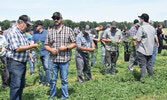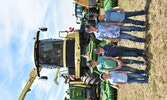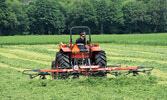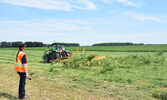By Lisa Boonstoppel-Pot
Forage and grazing specialist, Christine O’Reilly, was having a hard time keeping farmers in line, which was necessary for safety. They couldn’t wait to get into the rows of hay cut, raked, conditioned and tedded to compare the result from different makes of forage equipment at Forage Expo 2024.
Hundreds of farmers and machinery salesmen were on hand at the event which was hosted by the Ontario Forage Council (OFC) and Huron County and Eastern Valley Soil and Crop Improvement Associations. It was held in Huron County on July 4 at the farm of Mark Horst and family on Harriston Road near Gorrie.
The volume of farmers and the sheer size of the machinery were astounding to someone who hasn’t made hay in recent years and it was fascinating watching the process as machine manufacturers such as Massy Ferguson, Kubota, Fendt, Samasz, Vermeer, Kuhn, Krone, Bale Baron, CLAAS and others featured their haying equipment with salespersons giving a spiel before each pass.
“This is the biggest one of the market,” said Galen Wideman of the Krone KWT 2000 trailed rotary tedder which tossed hay from eight windrows as it made its pass down the field. “It’s 65 feet wide. We are of the mindset that you can go big or go home.”
This tedder has permanently lubricated gearboxes which gives peace of mind and increases the machine’s longevity. It also features OctoLink finger clutches and rotors are available with five, six or seven-tine arms. The tine arms mesh as they rotate, spreading the material uniformly across the working width.
In contrast, Travis Grubb brought a TE 4052 T four basket tedder, pulled by a Kubota M5-111 tractor. Grubb is a field product specialist with Kubota Canada and the tractor driver was Andrew Heida of D&S Downham Equipment in Stratford. “This is our little guy at 17 feet,” said Grubb. “A lot of farmers question what tedder is better to reduce compaction and this is it but it will spread hay out to a 10-foot width.”
Many more tedders, rakes and balers were featured at the event which allow farmers to see what’s new for 2024 while also witnessing this equipment in head-to-head field trials! Equipment also included windrow inverters, mergers, harvesters, dump wagons, large round balers, large square balers, and a small square bale bundler.
“This event provides an opportunity for farmers to view the latest technology available to harvest forage quickly with minimal loss and maximum quality,” states Patricia Ellingwood of the OFC. “Ian McDonald and Christine O’Reilly of OMAFRA will be in the field, working with the equipment companies to provide information to farmers and answer questions. This is important in making decisions on investments which ultimately enhance their farm operations in capacity, minimizing harvest losses, product quality and profitability.”
O’Reilly had the task of corralling enthusiastic farmers but she was all for it, saying ”Forage Expo provides a unique opportunity for farmers to see different makes of hay equipment operating side by side in the same field. It’s an event where all players in the forage space – input suppliers (seed, preservative, inoculant, etc), equipment dealerships, and farmers – can get together, network, and see some of the latest developments.”
Attendees are given a chance to take a closer look at each pass after the equipment runs. O’Reilly says “For mowers and mower-conditioners, farmers are looking at how clean of a cut, and what angle it’s at. They want to see how conditioners crack stems, and whether rollers were set too tight and bruised leaves. After tedders, fluffers, rakes, and mergers, they are looking at how these machines move the crop (either to spread it out or bring it into windrows), if they kick excess dirt into the forage, and whether they are turning the crop appropriately. The baler demos should produce solid, neat, well-wrapped or well-tied bales. And the wrappers should wrap neatly with enough plastic to keep air out and preserve the crop.”
Forages are critical for dairy, beef, goat, sheep and equine farmers because “forages are the foundation of ruminant rations. High quality forage provides much, or sometimes all, of the energy, protein, and fibre needed by the animal,” added O’Reilly. ◊






